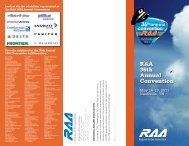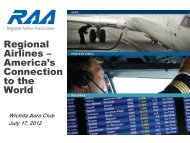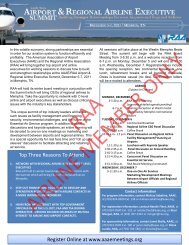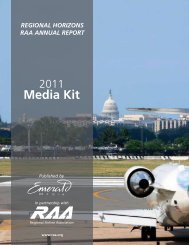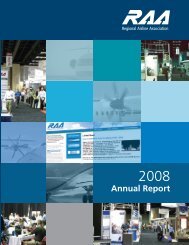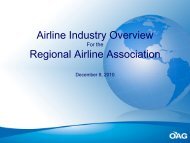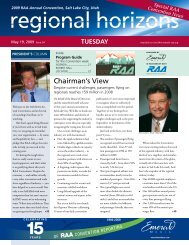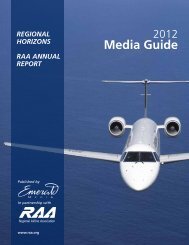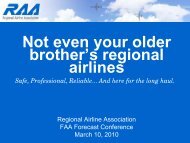Comments - Regional Airline Association
Comments - Regional Airline Association
Comments - Regional Airline Association
Create successful ePaper yourself
Turn your PDF publications into a flip-book with our unique Google optimized e-Paper software.
consequence of this prescriptive approach will be to constrain future innovation that wouldbenefit all passengers, including .passengers with disabilities. Adopting regulatory alternativeswill drastically eliminate unnecessary costs and focus on users and functionality.In adopting regulatory alternatives the Department should allow carriers to choose any of thefollowing options. Each option would provide all of the benefits included in the PRA, whilesignificantly reducing costs. Allowing this flexibility would permit each carrier to choose theoption that works best for its enterprise and its customers, while at the same time recognizingand promote airline investments already made in various web accessibility methodologies. Westress that a final rule mandating only one of the following options will not be in the passengers‟best interests because carriers have pursued a variety of approaches and invested in variousaccessibility technologies which encourages innovation and competition. Limited complianceoptions would inhibit innovation, and use of new technologies, ultimately limiting utility for allpassengers, and resulting in an undue burden for the industry.We also note, as the Department is aware, requiring WCAG 2.0 would set a very high bar thatexceeds federal government website accessibility requirements. No other government agency iscurrently required to meet the WCAG 2.0 Level A & AA standards. Only Section 508 currentlyimposes a website standard, which is WCAG 1.0 applying to the federal government. 20 Theairline industry should not be the “test case” or the first to implement WCAG 2.0, thegovernment should gain experience with this standard before imposing it on private industry.The U.S. Access Board asked in two Section 508 ANPRMs if a WCAG 2.0 standard would beappropriate to apply to the federal government. 21 The need for a second ANPRM indicates eventhe Federal government is concerned with proposing to adopt a WCAG 2.0 standard. 2220 36 CFR 1194.22 note.21 See ANPRM I, 75 Fed. Reg. 13457, March 22, 2010; ANPRM II, 76 Fed. Reg. 76640, December 8, 2011.22 For instance, there was confusion over whether strict compliance with WCAG 2.0 was proposed. See SocialSecurity Administration comments to the first ANPRM “We believe that The Board‟s solution is a good one—namely that WCAG AA equivalence, coupled with the additional requirement to meet provisions in the draft (e.g.sections 409, 413, etc.), will aid readability and understandability for many web developers. We do, however,suggest that the provision (or the advisory note) make explicit that the inverse is not true. Otherwise, members of thepublic can easily construe this to mean agency web sites should meet WCAG 2.0 (public misinterpretation on thisissue is evident today).(emphasis added). Docket ATBCB-2010-0001-0402; See also Department of HomelandSecurity comments, “The following language should be modified to ensure that the Section 508 Standards areapplicable, but that WCAG 2.0 conformance is acceptable, at the government’s discretion, as an equivalentStandard.Exception: Platforms, applications, and interactive content complying with the WCAG 2.0 Level AA SuccessCriteria and Conformance Requirements and, where applicable, 409 and 413 of this chapter shall not be required tocomply with other requirements of this chapter.Suggested replacement language:Platforms, applications, and interactive content, which meets the WCAG 2.0 definition of “Web page”, complyingwith the WCAG 2.0 Level AA Success Criteria and Conformance Requirements and, where applicable, 409 and 41312






